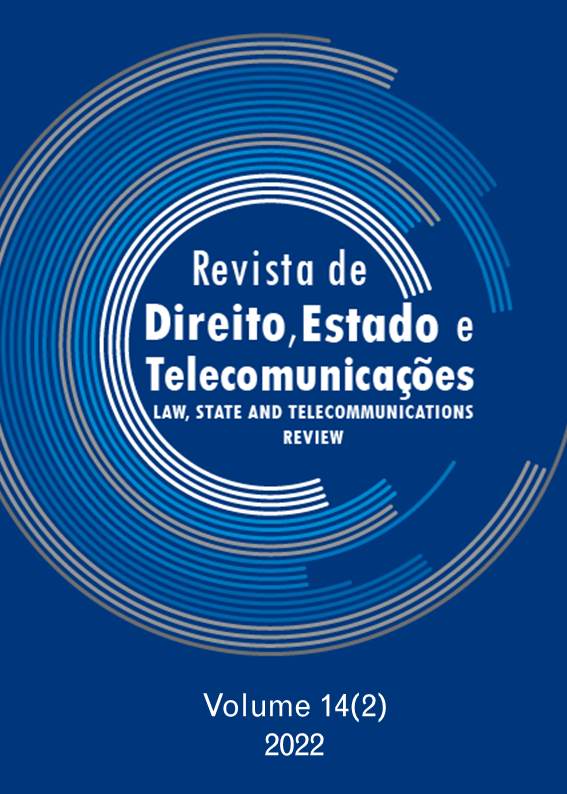Forensic Examination of Electronic Documents
DOI:
https://doi.org/10.26512/lstr.v14i2.40965Keywords:
Forgery. Falsification. Law enforcement agencies. Countering a crime. Expertise.Abstract
[Purpose] The purpose of the study is to reveal the concept and essence of forensic prevention of crimes of forgery of electronic documents, to identify problems in the use of information to establish a system of countering crime and document management.
[Methodology] The following approaches were used in the work: system-structural, dialectical, empirical. Forgery of electronic documents and their use is investigated not only within the framework of a single criminal case but also by a set of crimes committed depending on the mechanism that is the main one in the structure of criminal technologies.
[Findings] Lack of skills and knowledge about the latest forms of documents, methods of their forgery and use in the field of forensic investigations determine the reasons for the development of this condition. The analysis of investigative and judicial practice shows that cases of forgery of electronic documents are moved to separate proceedings due to the inability to fix the person who committed the crime. In some cases, court procedures are returned for additional investigation, since investigators cannot establish mechanisms for falsification tools and bring appropriate charges.
[Practical Implications] The practical significance lies in the formation of proposals for improving or making changes to the legislation, effectively improving the activities of law enforcement agencies involved in countering or combating the forgery of documents.
Downloads
References
BAEZA-YATES, R. A., & RIBEIRO-NETO, B. (1999). Modern information retrieval. London: Addison Wesley.
BAKER, J. N. (1956). Law of disputed and forged documents. Michigan Law Review, 54(5), 730-732.
BANDURKA, O. M., & LITVINOV, O. M. (2016). The concept and content of special criminological crime prevention. Bulletin of the Criminological Association of Ukraine, 2(13), 98-108.
BAXENDALE, D., & RENSHAW, I. D. (2019). The large-scale searching of handwriting samples. Journal of the Forensic Science Society, 19(4), 245-251.
BERGMAN, M. (2001). The Deep web: surfacing hidden value. Journal of Electronic Publishing, 7(1). https://doi.org/10.3998/3336451.0007.104.
CASEY, E. (2011). Digital evidence and computer crime. London: Elsevier Academic Press.
CHRISTLEIN, V., RIESS, C., JORDAN, J., & RIESS, C. (2012). An evaluation of popular copy-move forgery detection approaches. IEEE Transactions on Information Forensics and Security, 7(6), 1841-1854.
CIARDHUAIN, S. O. (2004). An extended model of cybercrime investigations. International Journal of Digital Evidence, 3(1), 1-22.
FERREIRA, L., HUANG, J., & CAI, R. (2020). A Copy-proof scheme based on the spectral and spatial barcoding channel models. IEEE Transactions on Information Forensics and Security, Tampere, 15, 1056-1071.
FIALKA, M. I. (2018). Forgery of documents as a way to evade military service (criminal law analysis). Bulletin of the Criminological Association of Ukraine, 2(19), 77-86.
FIALKA, M. I. (2019). The mechanism of individual criminal behaviour is associated with the falsification of documents. Legal Scientific Electronic Journal, 5, 266-270.
KAM, M., WESTEIN, J., & CONN, R. (1994). Proficiency of professional document examiners in writer identification. Journal of Forensic Sciences, 39(1), 5-14.
KANUNGO, T., HARALICK, R., & Phillips, I. (1993). Global and local document degradation models. In: Proceedings of the Second International Conference (pp. 5-13). London: IEEE.
KENT, K., CHEVALIER, S., GRANCE, T., & DANG, H. (2006). Guide to integrating forensic techniques into incident response. Gaithersburg: National Institute of Standards and Technology.
KERNIAKEVYCH-TANASIICHUK, Y. V., SEZONOV, V. S., NYCHYTAILO, I. M., SAVCHUK, M. A., & TSAREVA, I. V. (2021). Problems of forensic identification of handwriting in forensic examination. Journal of the National Academy of Legal Sciences of Ukraine, 28(1), 195-204.
MICHAEL, G., & BARRETT, D. (2011). Computer forensics jump start. Medway: Sybex.
POWERS, D. (2011). Evaluation: From precision, recall and f-measure to roc. International Journal of Machine Learning Technology, 2(1), 37-63.
SCHNEIDER, U., & SEIDEL, U. (2014). Current aspects in machine authentication of security documents. Part I: Do we need optical document security? Retrieved from: https://www.semanticscholar.org/paper/Current-aspects-in-machine-authentication-of-Part-1-Seidel/8b05a8dcbf458d0717b4c88e2e50369c3eb93c02. Access date: 04 August 2021.
STOLC, S., WILD, P., & VALENTIN, K. (2017). On interoperability of security document reading devices. In: Proceedings – 2016 European Intelligence and Security Informatics Conference, EISIC 2016 (pp. 9-15). Uppsala: IEEE Computer Society.
YARASKAVITCH, L., GRAYDON, M., & TOBIN, T. (2008). Controlled electrostatic methodology for imaging indentations in documents. Forensic Science International, 177(2-3), 97-104.
ZHANG, L., CHEN, C., & MOW, W. H. (2019). Accurate modeling and efficient estimation of the print-capture channel with application in barcoding. IEEE Transactions on Image Processing, Tampere, 28(1), 464-478.
Downloads
Published
How to Cite
Issue
Section
License
Copyright (c) 2022 Law, State and Telecommunications Review

This work is licensed under a Creative Commons Attribution 4.0 International License.
By submitting this paper to the Law, State and Telecommunications Review,
I hereby declare that I agree to the terms of the Creative Commons Attribution 4.0 International (CC BY 4.0).


